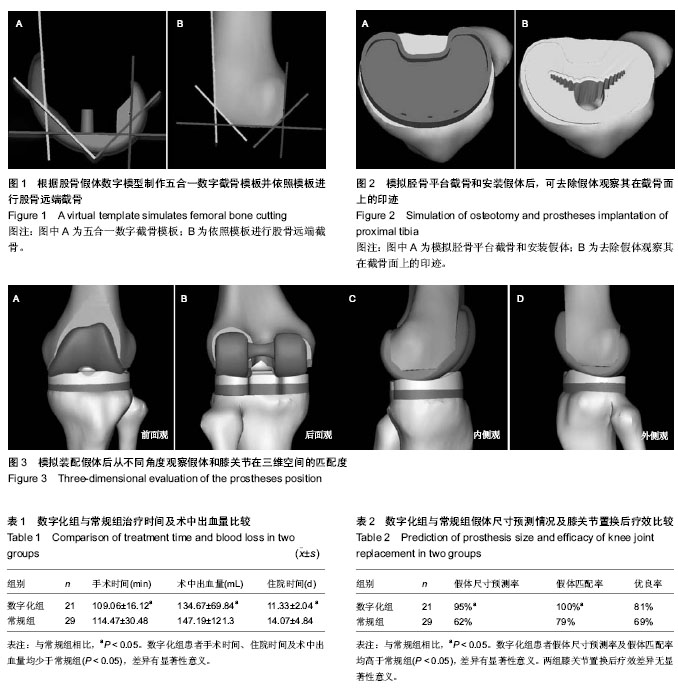| [1] Lo CS, Wang SJ, Wu SS. Knee stiffness on extension caused by an oversized femoral component after total knee arthroplasty: a report of two cases and a review of the literature. J Arthroplasty. 2003;18(6): 804-808.
[2] Mahoney OM, Kinsey T. Overhang of the femoral component in total knee arthroplasty: risk factors and clinical consequences. J Bone Joint Surg Am. 2010;92(5): 1115-1121.
[3] Ng FY, Jiang XF, Zhou WZ, et al. The accuracy of sizing of the femoral component in total knee replacement. Knee Surg Sports Traumatol Arthrosc. 2013;21(10): 2309-2313.
[4] Fitzgerald SJ, Trousdale RT. Why knees fail in 2011: patient, surgeon, or device? Orthopedics. 2011;34(9): e513-515.
[5] Mahfouz M, Abdel Fatah EE, Bowers LS, et al. Three-dimensional morphology of the knee reveals ethnic differences. Clin Orthop Relat Res. 2012;470(1): 172-185.
[6] Yue B, Varadarajan KM, Ai S, et al. Differences of knee anthropometry between Chinese and white men and women. J Arthroplasty. 2011;26(1): 124-130.
[7] Lim HC, Bae JH, Yoon JY, et al. Gender differences of the morphology of the distal femur and proximal tibia in a Korean population. Knee. 2013;20(1): 26-30.
[8] Cheng FB, Ji XF, Zheng WX, et al. Use of anthropometric data from the medial tibial and femoral condyles to design unicondylar knee prostheses in the Chinese population. Knee Surg Sports Traumatol Arthrosc. 2010;18(3): 352-358.
[9] 张健.国人膝关节尺寸与5种人工膝关节假体尺寸的对照[J].中国组织工程研究与临床康复, 2009, 13(4): 635-638.
[10] Hafez MA, Chelule KL, Seedhom BB, et al. Computer-assisted total knee arthroplasty using patient-specific templating. Clin Orthop Relat Res. 2006; 444: 184-192.
[11] Lee IS, Choi JA, Kim TK, et al. Reliability analysis of 16-MDCT in preoperative evaluation of total knee arthroplasty and comparison with intraoperative measurements. AJR Am J Roentgenol. 2006;186(6): 1778-1782.
[12] van der Linden-van der Zwaag HM, Wolterbeek R, Nelissen RG. Computer assisted orthopedic surgery; its influence on prosthesis size in total knee replacement. Knee. 2008;15(4): 281-285.
[13] Friederich N, Verdonk R. The use of computer-assisted orthopedic surgery for total knee replacement in daily practice: a survey among ESSKA/SGO-SSO members. Knee Surg Sports Traumatol Arthrosc. 2008;16(6): 536-543.
[14] Tyagi V, Kim TH, Hwang JH, et al. Imageless navigation assisted total knee arthroplasty with comprehensive gap balancing in medial osteoarthritic varus knees with anatomic variations. Comput Aided Surg. 2010;15(4-6): 90-97.
[15] 丁裕润, 王伟力. CT三维重建在全膝关节置换中的应用[J]. 中国组织工程研究, 2012, 16(48): 9020-9024.
[16] 林竹. 膝关节表面置换术前高精度数字化模板测量的临床应用[J]. 广州医药, 2012, 43(2):3-5.
[17] Fawzy E, Pandit H, Jenkins C, et al. Determination of femoral component size in unicompartmental knee replacement. Knee. 2008;15(5): 403-406.
[18] Arora J, Sharma S, Blyth M. The role of pre-operative templating in primary total knee replacement. Knee Surg Sports Traumatol Arthrosc. 2005;13(3): 187-189.
[19] Unnanuntana A, Arunakul M. The accuracy of preoperative templating in total knee arthroplasty. J Med Assoc Thai. 2007; 90(11): 2338-2343.
[20] Aslam N, Lo S, Nagarajah K, et al. Reliability of preoperative templating in total knee arthroplasty. Acta Orthop Belg. 2004; 70(6):560-564.
[21] Heal J, Blewitt N. Kinemax total knee arthroplasty: trial by template. J Arthroplasty. 2002;17(1): 90-94.
[22] 郭盛杰,张洪,李玉军,等.全膝关节置换术前模板测量预测术中假体型号:92例资料回顾[J].中国组织工程研究与临床康复, 2007, 11(40): 8070-8073.
[23] Cheng T, Pan XY, Mao X, et al. Little clinical advantage of computer-assisted navigation over conventional instrumentation in primary total knee arthroplasty at early follow-up. Knee. 2012;19(4): 237-245.
[24] 陈宣煌,林海滨,张国栋,等.基于三维重建髋臼骨折数字化植入物设计[J].中国实用医药, 2012, 7(23): 144-145.
[25] 张伟. 三维重建及快速成型在骨科临床的应用研究[D]. 天津医科大学, 2010.
[26] 吕厚忠,黄海样,张建春,等.数字骨科技术在髋臼骨折手术中的应用[J]. 中国骨科临床与基础研究杂志, 2011, 3(3): 193-198.
[27] 宋军,梅益彰,吴增城,等.复杂髋臼骨折复位及内固定的数字技术模拟研究[J].中国临床解剖学杂志, 2013, 31(4): 393-396.
[28] 汪光晔,张春才,许硕贵,等.基于真实CT数据骨科虚拟手术计划在髋臼骨折手术中的运用[J].中国组织工程研究与临床康复, 2011, 15(43): 7987-7990.
[29] 张国栋,林海滨,陈宣煌,等.基于多平面三维测量的髋臼骨折数字化内固定植入方案[J].中华临床医师杂志(电子版), 2012, 6(8): 2010-2015.
[30] Brown GA, Milner B, Firoozbakhsh K. Application of computer-generated stereolithography and interpositioning template in acetabular fractures: a report of eight cases. J Orthop Trauma. 2002;16(5): 347-352.
[31] Altman RD, Gold GE. Atlas of individual radiographic features in osteoarthritis, revised. Osteoarthritis Cartilage. 2007;15 Suppl A: A1-56.
[32] 蔡俊丰,袁锋,马敏,等.数字技术在个性化全膝关节置换股骨轴向力线控制中的应用[J].中华关节外科杂志(电子版), 2014,8(1): 91-95.
[33] Rousseau MA, Lazennec JY, Catonne Y. Early mechanical failure in total knee arthroplasty. Int Orthop. 2008;32(1): 53-56.
[34] Mihalko W, Fishkin Z, Krackow K. Patellofemoral overstuff and its relationship to flexion after total knee arthroplasty. Clin Orthop Relat Res. 2006;449:283-287.
[35] 翁习生,边焱焱,周熹,等. 人工全膝关节假体覆盖率与术后引流量的关系[J]. 中国骨与关节外科, 2013, z1: 48-51.
[36] Decking R, Markmann Y, Fuchs J, et al. Leg axis after computer-navigated total knee arthroplasty: a prospective randomized trial comparing computer-navigated and manual implantation. J Arthroplasty. 2005;20(3): 282-288.
[37] Molfetta L, Caldo D. Computer navigation versus conventional implantation for varus knee total arthroplasty: a case-control study at 5 years follow-up. Knee. 2008;15(2): 75-79.
[38] Matsumoto T, Tsumura N, Kurosaka M, et al. Prosthetic alignment and sizing in computer-assisted total knee arthroplasty. Int Orthop.2004;28(5): 282-285.
[39] Minoda Y, Watanabe K, Iwaki H, et al. Theoretical risk of anterior femoral cortex notching in total knee arthroplasty using a navigation system. J Arthroplasty. 2013;28(9): 1533-1537.
[40] Gervaise A, Naulet P, Beuret F, et al. Low-dose CT with automatic tube current modulation, adaptive statistical iterative reconstruction, and low tube voltage for the diagnosis of renal colic: impact of body mass index. AJR Am J Roentgenol. 2014;202(3): 553-560. |
